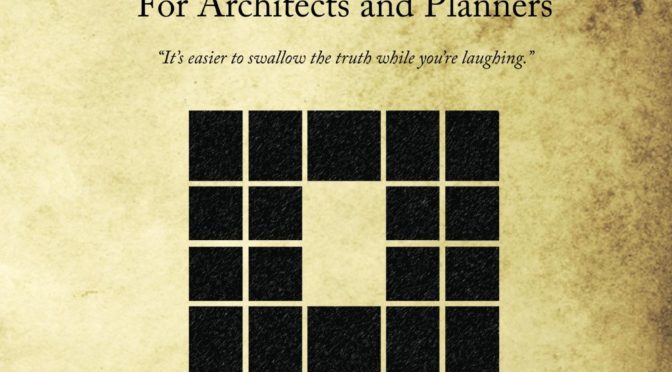 Planning Naked | May 2015
Planning Naked | May 2015
by Dr. Mark David Major, AICP, CNU-A, The Outlaw Urbanist contributor
Observations on the May 2015 issue of Planning Magazine.
1. I cannot believe the cover of this Special Issue on Transportation from Planning: The Magazine of the American Planning Association. The message could not be any clearer:
Transportation=Road Building=Moving Cars=Money $$$
At first, I thought – finally – APA has developed a satirical perspective on its own profession. Yeah, that was wishful thinking. The cover is insidious, especially given the contrary content of this month’s issue on road design, reduced parking requirements, etc. Let’s ‘fix’ this cover.

2. “The Mathematics of Urban Productivity” (pp. 9) has an exciting and really important finding buried in the text. “Human settlements are, first and foremost, social networks embedded in space (our emphasis),” wrote Scott Ortman, assistant professor of anthropology at the University of Colorado-Boulder in a paper published in Science Advances about a study of productivity in the Aztec city Teōtīhuacān (modern day Mexico City), “the productivity of cities depends… on their role as containers for social interaction.”
3. Despite (seemingly) editorial efforts to change the emphasis to police enforcement from road design, the message of “The Safest Streets: Vision Zero aims to eliminate all traffic fatalities” by Jay Walljasper (pp. 14) still comes through loud and clear. “Research shows that lowering a speed limit without other improvements like road design changes or improved police enforcement doesn’t work to slow traffc – it’s the roadway design (our emphasis) that affects the speed” (Charlie Zegger, UNC Pedestrian and Bicycle Information Center). It’s not an enforcement problem, it’s a design problem. This provides an especially galling contrast compared to the “pro-car, make money” message of this month’s Planning Magazine cover. Two steps forward, one step back.
4. Another good article “Releasing the Parking Brake on Economic Development” by Brian Canepa and Joshua Karlin-Resnick (pp. 22). “A recent study by the Transportation Research Board found that parking was oversupplied in mixed use district by an average of 65 percent.” It’s not only in mixed use districts and you don’t really need a study to see the obvious, just open your eyes and look. Accommodating parking for 2-3 days of the year (shopping days before Christmas) is just stupid. The example cited in Sacramento makes a clearcut case of how the real problem is created and perpetuated by the regulatory regime itself.
5. The logical conclusion of the above article and Donald Shoup’s excellent “Putting the Cap on Parking Requirements” article is the Buffalo model: complete eradication of minimum parking requirements in regulatory codes and allowing the market to determine what is needed on a case-by-case basis. The planning profession is not ready to adopt such a radical approach but they better start getting ready.
6. “Road (Funding) Rage” by Jon Davis – in combination with the insidious cover – reveals the real agenda of the American Planning Association and American Association of State Highway and Transportation Officials (AASHTO), which is organizations greedily sucking at the teat of the government (preferably Federal but State and local will do as well). Approximately one-third on the content (excluding advertisements) in this special issue is dedicated to funding, taxes, and cars.

7. “Towards a grounded theory of sustainable zoning” by Reid Ewing from the University of Utah in the Research You Can Use section advocates the concept of grounded or qualitative theory, which is really just normative theory because it is not testable or refutable, meaning it’s not theory at all in the scientific sense of the word. For normative theory, see Modernism planning.
8. It’s hard to know where to begin with Elizabeth Wood’s Viewpoint Article, “Celebrity Culture Meets Planning Culture”. I am guessing People Magazine passed on this article. According to Wood, Idina Menzel (the “the one and only, Adele Dazeem”, per John Travolta) plays a planner in the Broadway musical If/Then, she sang on Disney’s Frozen and has “millions of young Frozen fans”, ergo we can expect a “bumper crop of new planners” in the next generation. I guess I can see her point. I mean Madonna did play Eva Peron in Andrew Lloyd Weber’s Evita in 1996, Madonna had millions of young fans at the time, and now we are inundated with a bumper crop of ambitious young women who want to be the second wife of South American oligarchs… And that is how you do satire, APA *mic drop*.
Planning Naked is an article with observations and comments about a recent issue of Planning: The Magazine of the American Planning Association.






 Planning Naked | April 2015
Planning Naked | April 2015 5. Goodness, that looks like a space syntax model of Portland, Oregon on page 27 in the “Big Data” article!!! I don’t think it is but it looks like someone has been reading about space syntax.
5. Goodness, that looks like a space syntax model of Portland, Oregon on page 27 in the “Big Data” article!!! I don’t think it is but it looks like someone has been reading about space syntax.